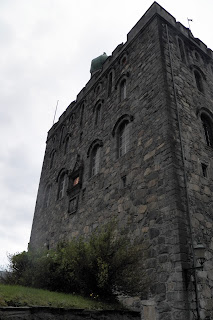For all of you facts
and figures guys here are some excerpts from the official Cruise Log that
was passed out to passengers last night.
First here is a little about the ship herself. The MS
Rotterdam is 780 feet in length with a width of 106 feet. She carries 1,229
guests and a crew of 601. Her maximum speed is 25 knots.
Since my boarding the MS Rotterdam in Harwich, England on
Sunday, September 13 and docking this morning, Saturday, September 26 in
Rotterdam, The Netherlands we have traveled a total of 3,382 nautical miles and
have visited the following Norwegian ports: Eidfjord, Alesund, Tromso, Alta,
Narvik, Molde and Begen.
Most days have been cloudy with either a fresh southerly or
easterly breeze accompanied with slight seas. The log however has recorded one
day at sea as moderate seas and near gale force easterly winds.
If you really want to get a good idea of how the sea is
performing, the best place to go in up on the deck with the pool. Take a nice
deck chair as close to the edge of the pool as you can possibly get. Now if you say sit there for an hour or so
and your book or body does not get splashed with water consider it a ‘slight
sea’ day.
On the other hand if you suddenly find yourself drenched in
pool water, without seaweed of course, this is what we call ‘moderate sea”. If perchance
the slosh is more like a tidal wave; Let me ask you, “Why are you not in the
bar, safe – sound – tipsy?”
Are you curious about Land and Nautical Miles? As luck would
have it our Cruise Log gives a nice little history. And if you can remember
this little tale you will be able to shine the next time this discussion comes
up.
“The Mile”
It comes to us from
the Romans, who had a distance of a thousand (“Mille”) double-steps. A Roman
Mile was just over 1400 meters long. Later, when the Normans conquered England,
William I divided up the country, other than crown lands, amongst the nobles
who supported his adventures.
The common people living on these “manors” were required to
give their services free for three or four days a week to the Lord of the manor
in return for such privileges as having a cottage and garden, grazing rights on
common ground, and the right to collect as much firewood from the Lord’s
forests as they were able.
As time went on, however, the people began to commute their
services by paying rent. The yeoman farmer developed and the manorial lands
were slowly broken up. To establish ownership, some unit of measurement was
required.
During the reign of Queen Elizabeth, an Act of Parliament
was introduced which stated that one-mile should be 5,280 feet in length.
At sea, however, the term “miles” has a mathematical basis
and the nautical mile is the length, in fact, of one minute of angle of
latitude.
As the earth is not a perfect sphere, but flattened at the
poles, this minute of area varies between 6,046 feet at the Equator to 6,108
feet at the poles; a mean of 6,076 is thus actually used. ~ From the Cruise Log of MS Rotterdam, September
2015
























